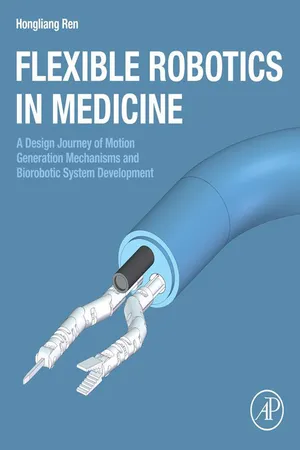
Flexible Robotics in Medicine
A Design Journey of Motion Generation Mechanisms and Biorobotic System Development
- 518 pages
- English
- ePUB (mobile friendly)
- Available on iOS & Android
Flexible Robotics in Medicine
A Design Journey of Motion Generation Mechanisms and Biorobotic System Development
About This Book
Flexible Robotics in Medicine: A Design Journey of Motion Generation Mechanisms and Biorobotic System Development provides a resource of knowledge and successful prototypes regarding flexible robots in medicine. With specialists in the medical field increasingly utilizing robotics in medical procedures, it is vital to improve current knowledge regarding technologies available. This book covers the background, medical requirements, biomedical engineering principles, and new research on soft robots, including general flexible robotic systems, design specifications, design rationale, fabrication, verification experiments, actuators and sensors in flexible medical robotic systems.
Presenting several projects as examples, the authors also discuss the pipeline to develop a medical robotic system, including important milestones such as involved regulations, device classifications and medical standards.
- Covers realistic prototypes, experimental protocols and design procedures for engineering flexible medical robotics
- Covers the full product development pipeline for engineering new flexible robots for medical applications, including design principles and design verifications
- Includes detailed information for application and development of several types of robots, including Handheld Concentric-Tube Flexible Robot for Intraocular Procedures, a Preliminary Robotic Surgery Platform with Multiple Section Tendon-Driven Mechanism, a Flexible Drill for Minimally Invasive Transoral Surgical Robotic System, Four-Tendon-Driven Flexible Manipulators, Slim Single-port Surgical Manipulator with Spring Backbones and Catheter-size Channels, and much more
Frequently asked questions
Information
Slender snake-like endoscopic robots in surgery
Abstract
Keywords
1.1 Introduction
1.2 Snake-like robots for surgery
1.2.1 Commercial products
| Name | Published year | Developer | Product feature | Surgical application |
|---|---|---|---|---|
| NeoGuide [4] | 2007 | NeoGuide Systems Inc. | Tip position sensor and insertion depth sensor | Colonoscopy |
| Flex Robotic System [5] | 2013 | Medrobotics | Access and visualization without laryngoscopy | Transoral surgery |
| ViaCath [6] | 2007 | EndoVia Medical | Contains an endoscope and two articulated instruments | NOTES |
| Master [7] | 2010 | EndoMaster Medical | Master-slave manipulation by tendon-sheath actuation | NOTES |
| CardioARM [8] | 2013 | Medrobotics | “Follow the leader” control | Cardiac surgery |
Table of contents
- Cover image
- Title page
- Table of Contents
- Copyright
- List of Contributors
- Preface: A design journey of biorobotic motion generation mechanisms and flexible continuum system development
- Chapter 1. Slender snake-like endoscopic robots in surgery
- Chapter 2. Prototyping soft origami quad-bellows robots from single-bellows characterization
- Chapter 3. Cable-driven flexible endoscope utilizing diamond-shaped perforations: FlexDiamond
- Chapter 4. Flexible steerable manipulator utilizing complementary configuration of multiple routing grooves and ball joints for stable omnidirectional bending
- Chapter 5. Modular origami joint operator to create bendable motions with multiple radii
- Chapter 6. Handheld flexible robot with concentric tubes aiming for intraocular procedures
- Chapter 7. Tendon routing and anchoring for cable-driven single-port surgical manipulators with spring backbones and luminal constraints
- Chapter 8. Compliant bending tubular mechanisms with variable groove patterns for flexible robotic drilling delivery
- Chapter 9. Tendon-driven linkage for steerable guide of flexible bending manipulation
- Chapter 10. Soft-bodied flexible bending mechanism with silent shape memory alloys aiming for robotic endoscopy
- Chapter 11. Comparative mechanical analysis for flexible bending manipulators with quad-tendon antagonistic pairs
- Chapter 12. Flexible robotic platform with multiple-bending tendon-driven mechanism
- Chapter 13. Design evolution of a flexible robotic bending end-effector for transluminal explorations
- Chapter 14. Force sensing in compact concentric tube mechanism with optical fibers
- Chapter 15. Electromechanical characterization of magnetic responsive and conductive soft polymer actuators
- Chapter 16. Robotic transluminal Pan-and-Tilt Scope
- Chapter 17. Single-port multichannel multi-degree-of-freedom robot with variable stiffness for natural orifice transluminal endoscopic surgery
- Chapter 18. EndoGoose: a flexible and steerable endoscopic forceps with actively pose-retaining bendable sections
- Chapter 19. Flexible drill manipulator utilizing different rolling sliding joints for transoral drilling through the tracheal tissue
- Chapter 20. Thermo-responsive hydrogel-based circular valve embedded with shape-memory actuators
- Chapter 21. OmniFlex: omnidirectional flexible hand-held endoscopic manipulator with spheroidal joint
- Index
